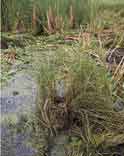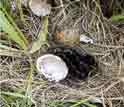 Alberta's WaterIntroductionPublications Climate Change Industrial Impacts Agricultural Impacts Urban Impacts Biodiversity Loss Definitions Links Site Map |
 |

The Effects of Cattle Grazing on Wetland-dependent Birds in the Aspen ParklandThis information is adapted from a poster presentation created by Robb. Introduction
Robb's objective was to investigate the diversity, relative abundance, and nest success of wetland-dependent birds in relation to grazing intensity on adjacent lands. He also investigated the relationship between grazing intensity in the uplands and the impact on emergent vegetation communities. Study AreaThe study area included 90 wetlands within 45 quarter sections between Tofield and Pine Lake, Alberta. This area of Aspen Parkland responds well to rainfall, allowing intensive grazing. The pastures included native/naturalized and tame pastures, which were separated into six categories of grazing intensities:
Methods
|  |
 |  |
 Alberta is host to approximately 5.7 million cattle, and cattle numbers are expected to increase drastically in the future. The potential impacts to waterfowl include:
Alberta is host to approximately 5.7 million cattle, and cattle numbers are expected to increase drastically in the future. The potential impacts to waterfowl include:
 Native idle or lightly grazed
Native idle or lightly grazed